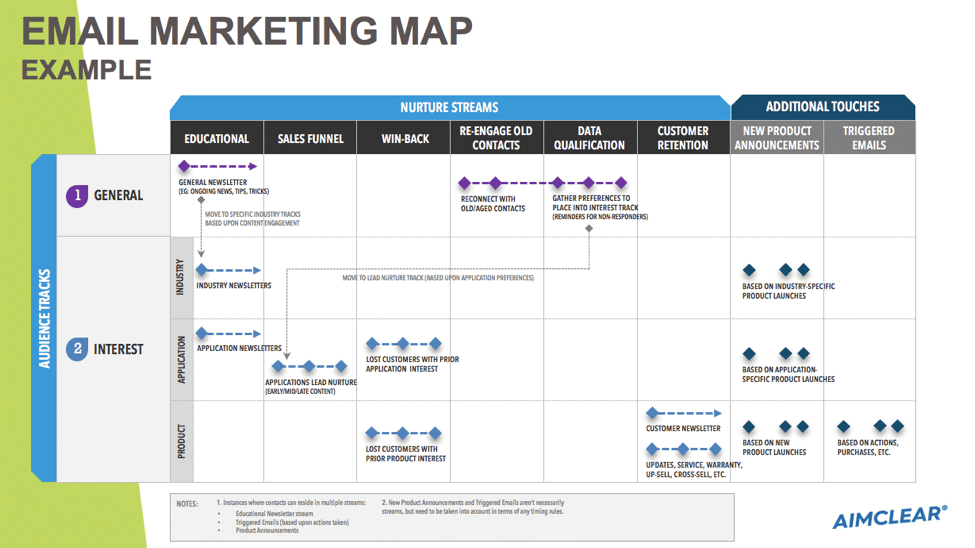Getting inquiries from your marketing program is an investment. A recent benchmark study shows that even intent-driven channels like Google PPC can cost an average of $60 just to generate an action from someone who is actively searching.
Effective marketing efforts are not one-touch-and-done; it requires a multi-touch approach to convert as many prospects as possible into qualified leads. While this concept is universal, it’s particularly true in B2B and industries where products have higher prices and longer consideration cycles leading up to a sale. It’s the reason why lead nurture techniques, such as retargeting and email, continue to gain in popularity.
When it comes to email nurture and all the potential that marketing automation tools bring, there is much to consider. Smart marketing organizations know that a well-thought-out nurture program is essential to ensure no lead is left behind, but getting started can quickly feel like an overwhelming task. Where do you start? How do you segment audiences? How many streams should there be? How do you balance ongoing education with actual selling? Where do customer retention efforts fit, if at all? Let’s break it down.
Step 1: Prioritize audience tracks
The place to start is with your audience. When considering audience tracks, have a clear understanding of which customer segments are most important to your business and prioritize around these. Here are a few common examples:
Industry/market
There may be certain industries or markets that are particularly important to your business. For example, the education industry could be an important market for IT companies, network providers or those simply looking to get a foothold into a younger generation of users. Other key industries could include retail, hospitality, healthcare, broadcasting ” the list goes on.
Application/use
There may also be common, but specific, uses for your range of products and/or services. Maybe you have an increasing number of customers who are testing power and energy efficiency in hybrid vehicles, or a large audience that measures radio frequencies. Speaking to application needs is an effective way to segue into how a product, or suite of products, can help solve their pain points, particularly when applications and products are complex in nature.
Product/service
In some cases, the product or service need is obvious, for example, needing a new phone to replace an old one. Here, the audience is interested in specific product benefits and specifications, as well as comparisons between different brands. In these cases, it would make sense to segment audiences by product category interest, for example, phones, laptops, tablets, MP3 players, etc. Depending on the depth of your product range, consider breaking this out further by criteria such as price point and feature set.
Persona
Your company may have already defined specific customer personas that take into account all of the above, and more. In this case, simply breaking out tracks by persona would be a good approach to use when defining audience tracks.
General/other
Even after you go through this audience exercise, there will often be a general bucket of contacts in your database that don’t fit into any of the segments you’ve defined. These are contacts that you either don’t have enough data on, or they exist within a segment that isn’t a big area of focus. This is expected and your nurture streams can account for this, as well as help with future segment definition.
Step 2: Identify nurture streams
Once you have a clear idea which audience segments are most important to you, think about the different streams you’ll use to nurture these segments. Here are some approaches to consider:
Marketing and sales funnel
This is typically what marketers think about when considering email nurture. Essentially, it’s the stream that takes the audience on a journey through the marketing funnel, putting them on a calculated path to purchase. Very often these streams will start with an educational video, blog post or whitepaper, then nurture people with content that moves into more specific applications, product solutions and offers.
Educational newsletter
In some cases, there may be contacts in a prolonged learning mode. While they don’t have an immediate, or even near-term, need to buy products or services, they are in your target market and can be classed as potential future prospects. With these contacts, it’s important to keep your company front-of-mind should their needs change in the future. Rather than prematurely forcing these contacts towards a purchase (and risk an irritated opt-out), an educational newsletter stream can help keep them up to date with interesting industry news and helpful tips.
Reconnecting with old/aged contacts
You may find contacts in your database with whom you haven’t communicated in years, potentially decades. This is common when various databases are being consolidated within a large company, or there’s been a general lack of marketing activity. In this instance, it’s worth spending the time to remove contacts who are no longer relevant and reconnect with those who are. When interest has been reestablished, these people can be funneled into a data-qualification track to gather specific preference information and get them on the most relevant communication path.
Data qualification
Very often you will have a bucket of contacts in your database that lack data ” data you need to match them to a particular track. If you have many of these contacts, it’s worthwhile building a track that gathers additional preference data to get insight into their areas of interest (e.g. the industry they work in, applications that interest them, whether they want to keep up to date with the latest news, and if they are researching solutions or have an immediate buying need). You can approach this in different ways. Either gather data all at once and trigger reminders to non-responders, or ” if the amount of data you require is substantial ” build this information over time using multiple touches rather than bombarding the recipient with everything at once.
Win back
Even the best companies in the world don’t win all the business that comes their way due to a variety of reasons. When enough time has passed, new offerings have been developed and customer renewal cycles are on the horizon, there’s an opportunity to have a stream that attempts to win back lost prospects. Depending on the information your sales team ties to lost opportunities, time-based rules can be set and streams can be tailored to address improved technologies, better usability, and new price points and feature sets, among others.
Customer retention
It costs a lot less to retain an existing customer than it does to acquire a new one, which is why it’s important not to neglect your customer base. A customer retention stream can include content covering product-specific tips and tricks. There are also opportunities to remind customers about service needs/plans and product warranty renewals, cross-sell accessories or complementary products, and up-sell or offer trade-in offers on new products.
Step 3: Map out tracks and streams
Once you’ve prioritized your audience tracks and nurture streams, it’s time to map these out at a high level. It’s often helpful to build out a matrix that plots your audience tracks against nurture streams.
Remember to capture any additional thoughts and notes (for example, whether contacts can belong to multiple tracks) and indicate if certain tracks feed into other tracks. Also try to account for any instances of email communications that aren’t necessarily part of an ongoing stream, but are triggered by certain actions/behaviors, timing or announcements.
Here’s an example of what this may look like:

Step 4: Build out stream details
Once you have a map, build out the details for each individual stream.

To know how this stream should look, we first need a clear understanding of the content available, by application, and how each of these assets correlate to the early/mid/late stages of the customer journey. A content audit is an important step that will help identify this, as well as any gaps and opportunities that need to be filled prior to building out your stream.
Here’s an example of how this could be built out, taking into account topic themes (from how-tos to brand and product comparisons) and media types (from videos to detailed reports and side-by-sides), aligned to the customer journey. It’s then a case of repeating the process for each of your planned streams within your nurture map.

On the surface, email may not seem as sexy as other digital marketing channels like social media or search engine marketing. Yet it continues to be one of the most efficient and high-returning channels for delivering a continued stream of qualified marketing leads.
When embarking on your email nurture plan, prioritization is key. Start by identifying your most important audience segments, then decide what kinds of streams are highest priority. From there, map out audience streams and tracks before focusing on the details behind each stream. Work closely with your marketing automation team for continued optimization, updates and additions based upon where you find most success. And as you go through this process, consider how your email nurture program (of known database contacts) can be used to complement your retargeting efforts (of yet-to-be-acquired contacts).
So what are you waiting for? Get planning today and download your very own Email Nurture Map template.









